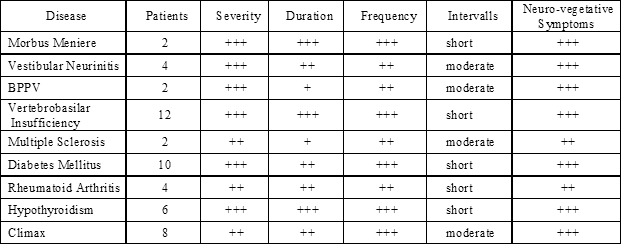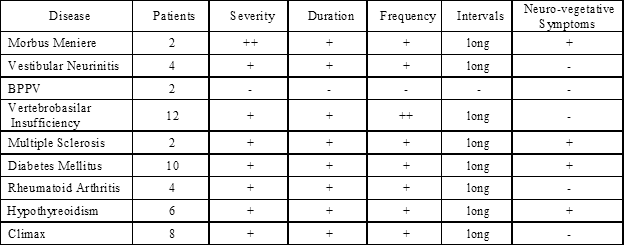

|
Journal Home Contents Preview Next |
Pro Otology
Balkan Journal of Otology & Neuro-Otology, Vol. 3, No 1:43-45 © 2003
All rights reserved. Published by Pro Otology Association
Piracetam* in Patients with Chronic Vertigo
R. Benchev, Zl. Zhelyazkova
Department of Otorhinolaryngology
Medical Institute of Ministry of Interior, Sofia, Bulgaria
ABSTRACT
Objective: The purpose of this study was to observe the effectiveness of Piracetam* in treating chronic vertigo.
Study Design: The study design was a retrospective analysis.
Setting: This study was performed at the Department of Otorhinolaryngology in the Medical Institute – Ministry of Interior, Sofia.
Patients: The study included 40 patients with chronic vertigo.
Intervention: The patients were treated with Piracetam /Nootropil®/ for 8 weeks –2.4 g/day (2x1.2g).
Main Outcome Measures: The patients passed precise otorhinolaryngological and neurotological examination including pure tone audiometry, observation for nystagmus, static and kinetic tests, posturography before and after the treatment.
Results: The frequency of the vertiginous attacks in patients with the whole amount of the different diseases decreased; the duration of the vertigo diminished in patients with diabetes mellitus and climax, but remained the same in patients with neuritis of the cochleo-vestibular nerve and benign positional paroxysmal vertigo; the severity of the vertigo and the vegetative complaints decreased; the intervals between the vertiginous attacks increased.
Conclusions: The results of the treatment encourage us to recommend Nootropil for curing chronic vertigo of both peripheral and central origin in patients with the different previously mentioned diseases.
Key words: Chronic vertigo, Nootropil.
Pro Otology 1: 43-45, 2003
INTRODUCTION
Vertigo is not a disease but a cardinal symptom of vestibular dysfunction. It may be defined as an illusion of movement of the environment or of oneself. Vertigo is a sensation of altered orientation in space and of motion without external stimuli. It is an unpleasant symptom frequently accompanied by nausea, vomiting, dysequillibrium, and unsteadiness (3). Vertigo can result from a wide variety of diseases affecting either peripheral or central vestibular system. Swaying, rocking, staggering, weakness, a swimming or wavy sensation is associated with chronic vertigo. Classically the differentiation between central and peripheral causes of vertigo has been made by the duration of vertiginous attack, that is, episodic or constant. Although constant vertigo is definitely associated with central etiology, many central processes produce episodic vertigo, especially in the early stages (1,2). Some of the patients have chronic vertigo characterized by almost continuous symptoms of variable severity punctuated by periodic exacerbations or episodes (4,5).
The qualities of vertigo that must be determined are the following:
-severity of vertiginous attacks;
-duration of associated incapacity;
-frequency of episodes;
-intervals between the vertiginous attacks;
-precipitating factors as nausea, neuro-vegetative symptoms;
-instability, imbalance.
Effective symptomatic treatment of chronic vertigo remains a difficult therapeutic challenge. Pharmacotherapy is required for that kind of treatment. Piracetam has been shown to be effective in vertigo of both central and peripheral origin. The dosage we used was 2.4 g/day (2x1.2g) for 8 weeks. Piracetam was well tolerated and free from serious adverse events.
| Table 1. Characteristics of vertigo, caused by different diseases before the treatment. |

|
PATIENTS AND METHODS
50 patients of either gender (34 female and 16 male), aged between 30 and 75 years with chronic vertigo of at least 3 months duration and with 2 or more acute episode or exacerbations each month, were enrolled in the study. Vertigo was severe enough to interfere with social and professional life. The study design included the following groups:
A. Patients with vestibular disorders of peripheral origin, caused by the following diseases:
- Morbus Meniere – 2 patients;
-Vestibular neurinitis with recurrent vertigo – 4 patients;
- Benign positional paroxysmal vertigo – 2 patients.
B. Patients with vestibular disorders of central origin, caused by the following diseases:
- Vertebrobasilar insufficiency – 12 patients;
- Multiple sclerosis – 2 patients.
C. Patients with vestibular disorders, caused by metabolic derangements as:
- Diabetes mellitus – 10 patients;
- Rheumatoid arthritis – 4 patients;
- Hypothyreoidism – 6 patients;
- Climax – 8 patients.
The diagnosis was clinically, otorhinolaryngologically and neurotologically established by the examinations. The specific otoneurological parameters were studied including assessment of spontaneous, latent and positional nystagmus; stato-kinetic tests and posturography before and after the treatment.
RESULTS
After 8 weeks of treatment, the severity of the vertigo and the neuro-vegetative complaints such as nausea, vomiting and paleness decreased; the intervals between the vertiginous attacks increased; the duration of vertigo crisis diminished; the frequency of the vertiginous attacks also decreased. There was no imbalance and instability between the episodes.
| Table 2. The characteristics of vertigo after the treatment with Piracetam /Nootropil/. |

|
| Table 3. The characteristics of vertigo after the treatment with Piracetam /Nootropil/. |

|
DISCUSSION
The pathophysiology of vertigo and the ability to compensate in the presence of this disorder are dependent on central nervous function. The whole vestibular system, including the oculomotor system, is served by more than 50 nuclei in the central nervous system and, as such is the most complex structure in the brain.
The nootropic agent Piracetam exerts effects through actions on cerebral neurotransmission. It acts by restoring both the number and function of cholinergic (muscarinic) and excitatory amine (N-methyl-D-aspartate) receptors in aged rats and mice and the release of dopamine after hypoxia (7). Thus, during the excitatory phase of neurotransmission of impulses along the vestibular nerve in the time of the vestibular attack, nootropic agent stops the transmission and inhibiting input from the vestibular apparatus. The drug reduces nerve action potentials from the vestibular sensory organs to the brainstem. The effect of Piracetam on vertigo appears to be prophylactic in that it diminishes the number of episodes or exacerbations and improves background symptoms between episodes.
There is a nonspecific modulation of the neurotransmission due as well to the ability of piracetam to restore neuronal membrane fluidity (7). The increase in neuronal membrane fluidity observed after Piracetam administration in aging may explain both the improvement in various membrane bound cell functions and why clinical benefit usually occurs when cell function is compromised (6). Piracetam improves higher cerebral integrative functions but does not possess sedative or psycho stimulant properties.
Possessing anticholinergetic activity, the drug diminishes the excitability of neurons in the vestibular nuclei. It suppresses both the spontaneous firing rate and the response to vestibular nerve stimulation. Piracetam acts on the vestibular nuclei, which project to oculomotor, spinal, cerebellar and cerebral areas in the brainstem. Thus it appears to enhance the normal processes of vestibular compensation and habituation – recovery of oculomotor and postural function in patients with both peripheral and central vertigo. The drug accelerates spontaneous recovery, reinforces and stabilizes adaptation and restoration of balance (7).
Piracetam has a positive effect in presbyvertigo. The ischemia in patients, suffering from vertebrobasilar insuffeciency is a result of arterosclerosis and generally occurs in the older age group. Piracetam increases intra-labyrinthine blood flow and oxyganation of sensory tissue. It stimulates the sinthesis of AMP and ATP and thus prevents the neural cells of hypoxia and improves the metabolism in the cells of the vestibular system.
CONCLUSIONS
Clinical trials have shown Piracetam to be of particular value in the treatment of chronic or recurrent vertigo. The drug in a dose of 2.4 g/day (2x1.2g) diminishes the frequency of exacerbations of vertiginous attacks; reduces the severity of the vestibular disorders and duration of associated incapacity. The results of the treatment encourage us to recommend the Nootropil for curing chronic vertigo of both peripheral and central origin in patients with the different previously mentioned diseases.
REFERENCES
Badke MB, Pyle GM, Shea T, et al. Outcomes in Vestibular Ablative Procedures. Otology& Neurotology 2002;23(4):504-9.
Baumiou DE, Davies RA, McKee M, et al. The Effect of Severity of Unilateral Vestibular Dysfunction on Symptoms, Disabilities and Handicap in Vertiginous Patients. Clin Otolaryngol 1999;24(1):31-8.
Jackler R, Brackmann D. Neurotology. Mosby 1994:145-7.
Ishikawa K, Cao ZW, Wang Y, et al. Dynamic Locomotor Function in Normals and Patients with Vertigo. Acta Otolaryngol 2001; 121(2):241-4.
Mendel B, Bergenius J, Langius A. Dizziness Symptom Severity and Impact on Daily Living as Perceived by Patients Suffering from Peripheral Vestibular Disorder. Clin Otolaryngol 1999;24(4):286-93.
Oosterveld WJ. The Effectiveness of Piracetam in Vertigo. Pharmacopsychiatry 1999;32 (Suppl.):54-60.
Rosenhall U, Deberdt W, Friberg U, ET AL. Piracetam in Patients with Chronic Vertigo. Clin Drug Invest 1996;11(5):251-60.
|
Pro Otology |
Journal Home Contents Preview Next |